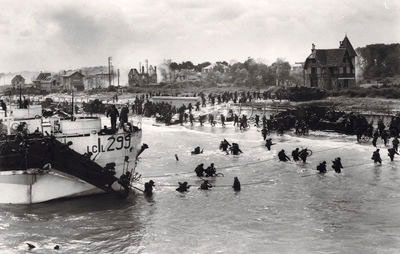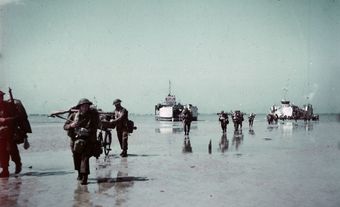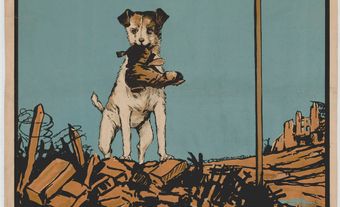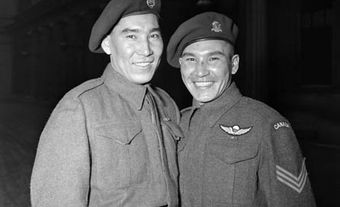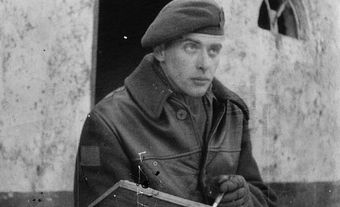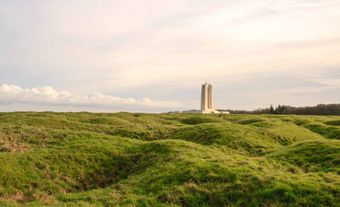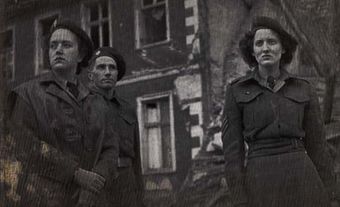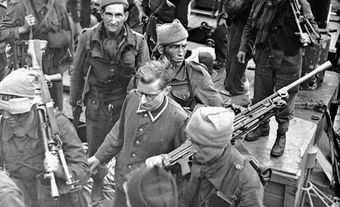The Second World War was a defining event in Canadian history, transforming a quiet country on the fringes of global affairs into a critical player in the 20th century's most important struggle. Canada carried out a vital role in the Battle of the Atlantic and the air war over Germany and contributed forces to the campaigns of western Europe beyond what might be expected of a small nation of then only 11 million people. Between 1939 and 1945 more than one million Canadian men and women served full-time in the armed services. More than 43,000 were killed. Despite the bloodshed, the war against Germany and the Axis powers reinvigorated Canada's industrial base, elevated the role of women in the economy, paved the way for Canada's membership in NATO, and left Canadians with a legacy of proud service and sacrifice embodied in names such as Dieppe, Hong Kong, Ortona and Juno Beach.
(This is the full-length entry about the Second World War. For a plain-language summary, please see Second World War (Plain-Language Summary).)
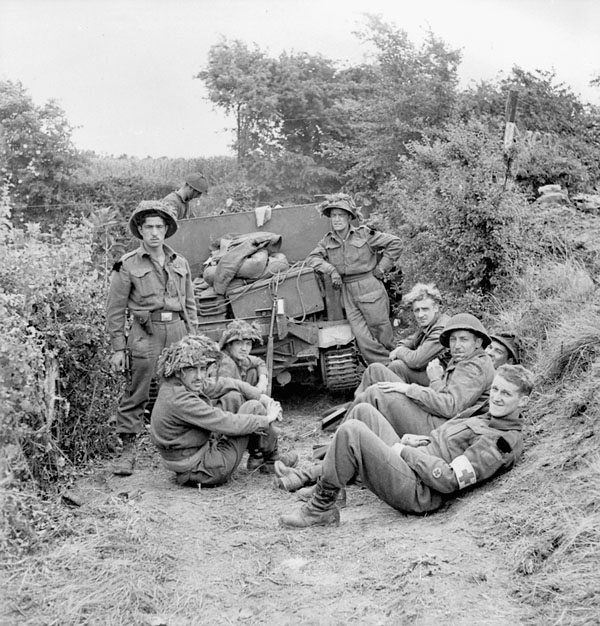
The Path to War
Memories of the First World War — the tragic loss of life, the heavy burden of debt and the strain on the country's unity imposed by conscription—made Canadians, including politicians of all parties, loath to contemplate another such experience. Initially, Prime Minister William Lyon Mackenzie King warmly supported British Prime Minister Neville Chamberlain's policy of appeasing German leader Adolf Hitler. When Chamberlain postponed war by sacrificing Czechoslovakia in the Munich crisis of September 1938, King thanked him publicly, and Canadians in general certainly agreed. Nevertheless, the shock of this crisis likely turned opinion towards accepting war to check the advance of Nazism. Only gradually did ongoing Nazi aggression alter this mood to the point where Canada was prepared to take part in another great war. King himself had no doubt that in a great war involving Britain, Canada could not stand aside.
Declaration and Mobilization
When the German attack on Poland on 1 September 1939 finally led Britain and France to declare war on Germany, King summoned Parliament to"decide," as he had pledged. Declaration of war was postponed for a week, during which Canada was formally neutral. The government announced that approval of the "Address in reply to the Speech from the Throne,"which stated the government's decision to support Britain and France, would constitute approval of a declaration of war.
On September 9 the address was approved without a recorded vote, and war was declared the following day. The basis for parliamentary unity had in fact been laid in March, when both major parties accepted a program rejecting conscription for overseas service. King clearly envisaged a limited effort and was lukewarm towards an expeditionary force. Nevertheless, there was enough pressure to lead the Cabinet to dispatch one army division to Europe. The Allies' defeat in France and Belgium in the early summer of 1940 and the collapse of France frightened Canadians. The idea of limited and economical war went by the board, at which point the only limitation was the pledge against overseas conscription. The armed forces were rapidly enlarged, conscription was introduced June 1940 for home defence (see National Resources Mobilization Act), and expenditure grew enormously.
Dieppe, Hong Kong and Italy
The army expanded, and by late 1942 there were five divisions overseas, two of them armoured. In April of that year the First Canadian Army was formed in England under Lieutenant-General A.G.L. McNaughton. In contrast with the First World War, it was a long time before the army saw large-scale action. Until summer 1943 the force in England was engaged only in the unsuccessful Dieppe Raid (19 August 1942), whereas two battalions sent from Canada had taken part in the hopeless defence of Hong Kong against the Japanese in December 1941. Public opinion in Canada became disturbed by the inaction, and disagreement developed between the government and McNaughton, who wished to reserve the army for a final, decisive campaign.
The government arranged with Britain for the 1st Canadian Infantry Division to join the attack on Sicily in July 1943, and subsequently insisted upon building its Mediterranean force up to a two-division corps (by adding the 5th Division). This produced a serious clash with McNaughton, just when the British War Office, which considered him unsuited for field command, was influencing the Canadian government against him. At the end of 1943 he was replaced by Lieutenant-General H.D.G. Crerar.
The 1st Division was heavily engaged in the Sicilian campaign as part of the British Eighth Army, and subsequently took part in the December 1943 advance up the mainland of Italy, seeing particularly severe fighting in and around Ortona. ( See also The Italian Campaign.) In the spring of 1944 Canadians under Lieutenant-General E.L.M. Burns played a leading role in breaking the Hitler Line barring the Liri Valley. At the end of August, the corps broke the Gothic Line in the Adriatic sector and pushed on through the German positions covering Rimini, which fell in September. These battles cost Canada its heaviest casualties of the Italian campaign.
The final phase of Canadian involvement in Italy found 1st Canadian Corps, now commanded by Lieutenant-General Charles Foulkes, fighting its way across the Lombard Plain, hindered by mud and swift-flowing rivers. The corps' advance ended at the Senio River in the first days of 1945. The Canadian government, so eager to get its troops into action in Italy, had soon begun to ask for their return to join the main Canadian force in Northwest Europe. Allied policy finally made this possible early in 1945, and the 1st Corps came under the First Canadian Army's command in mid-March, to the general satisfaction of the men from Italy. All told, 92,757 Canadian soldiers of all ranks had served in Italy, and 5,764 had lost their lives.
The Normandy Campaign
In the final great campaign in northwest Europe, beginning with the Normandy Invasion (code name Operation Overlord) on 6 June 1944, the First Canadian Army under Crerar played an important and costly part. The army's central kernel was the 2nd Canadian Corps, under Lieutenant-General G.G. Simonds, who had commanded the 1st Division in Sicily; it was composed of the 2nd and 3rd Canadian Infantry Divisions and the 4th Canadian Armoured Division. Throughout, the army was part of the 21st British Army Group commanded by General Sir (later Field-Marshal Lord) Bernard Law Montgomery.
In the landing phase, only the 3rd Division and the 2nd Canadian Armoured Brigade were engaged and fighting under the 2nd British Army. These formations landed on D-Day on a section of Canadian-designated shoreline code-named Juno Beach. There was bitter fighting on the beach, and subsequently as the Canadians moved inland.
The Canadian formations played a leading part in the breakout from the Normandy bridgehead in August, fighting against fierce opposition to reach the French town of Falaise and subsequently to close the gap south of it through which the enemy was retiring to avoid being trapped between the British and Canadians coming from the north and the Americans approaching from the south. Falaise was taken on August 16 and on the 19th the Allies finally made contact across the gap.
Belgium, Holland and Germany
The next phase was one of pursuit towards the German frontier. The First Canadian Army, with the 1st British Corps under command, cleared the coastal fortresses, taking in turn Le Havre, Boulogne, and Calais. Early in September the British took Antwerp, but the enemy still held the banks of the Scheldt River between this much-needed port and the sea. The Canadians fought a bitter battle to open the river through October and the first week of November. (See Canada and the Battle of the Scheldt.)
The first major Canadian operation of 1945, the Battle of the Rhineland, was to clear the area between the Maas and the Rhine rivers; it began February 8 and ended only March 10 when the Germans, pushed back by the Canadians and the converging thrust of the 9th US Army, withdrew across the Rhine. The final operations in the west began with the Rhine crossing in the British area on 23 March; thereafter, the First Canadian Army, still on the left of the line, liberated east and north Netherlands and advanced across the northern German plain. (See Liberation of the Netherlands). When the Germans surrendered on Field-Marshal Montgomery's front on 5 May, the 2nd Canadian Corps had taken Oldenburg, and the 1st Canadian Corps was standing fast on the Grebbe River line while, by arrangement with the Germans, food was sent into the starving western Netherlands. (See Canada and the Dutch Hunger Winter.) The entire campaign had cost the Canadian Army 11,336 fatalities. Some 237,000 men and women of the army had served in northwest Europe.
Take the quiz!
Test your knowledge of the liberation of the Netherlands by taking this quiz, offered by the Citizenship Challenge! A program of Historica Canada, the Citizenship Challenge invites Canadians to test their national knowledge by taking a mock citizenship exam, as well as other themed quizzes.
The Air Campaign
The war effort of the Royal Canadian Air Force was deeply affected by its management of the British Commonwealth Air Training Plan. Great numbers of Canadians served in units of Britain's Royal Air Force, and the growth of a national Canadian air organization overseas was delayed. Nevertheless, by the German surrender, 48 RCAF squadrons were overseas, virtually completely manned by Canadian officers and men. A landmark was the formation of No. 6 (RCAF) Bomber Group of the RAF Bomber Command on 1 January 1943. It grew ultimately to 14 squadrons. It was commanded successively by Air Vice-Marshals G.E. Brookes and C.M. McEwen. The Bomber Command's task was the night bombing of Germany, a desperately perilous job calling for sustained fortitude. Almost 10,000 Canadians lost their lives in this command.
Canadian airmen served in every theatre, from bases in the UK, North Africa, Italy, northwest Europe and southeast Asia. Squadrons in North America worked in antisubmarine operations off the Atlantic coast and co-operated with US air forces against the Japanese in the Aleutian Islands. At one time or another seven RCAF squadrons served in the RAF's Coastal Command over the Atlantic. RCAF aircraft destroyed or had a part in destroying 20 enemy submarines. In the northwest Europe campaign of 1944–45, the RCAF deployed 17 squadrons. During the war 232,632 men and 17,030 women served in the RCAF, and 17,101 lost their lives.
The Naval War
The Royal Canadian Navy was tiny in 1939, but its expansion during the war was remarkable: it enlisted 99,688 men and some 6,500 women. It manned 471 fighting vessels of various types. Its primary task was convoy, protecting the troop and supply ships across the Atlantic. It carried an increasing proportion of this burden, fighting grim battles sometimes of several days' duration with U-boat "wolfpacks." Its vast expansion produced some growing pains; in 1943 measures had to be taken to improve its escort vessels' technical equipment and in some cases crew training. During the war it sank or shared in sinking 33 enemy submarines.
After the Atlantic Convoy Conference in Washington in March 1943, the Canadian Northwest Atlantic Command was set up, covering the area north of New York City and west of the 47th meridian; a Canadian officer, Rear-Admiral L.W. Murray, was responsible for convoys in this area. Apart from their main task in the Battle of the Atlantic, Canadian naval units took part in many other campaigns, including supporting the Allied landings in North Africa in November 1942; and to the Normandy operations of June 1944, the RCN contributed some 110 vessels and 10,000 men.
During the war it lost 24 warships, ranging from the "Tribal " class destroyer Athabaskan, sunk in the English Channel in April 1944, to the armed yacht Raccoon, torpedoed in the St Lawrence in September 1942 (see U-Boat Operations). In personnel, the navy had 2,024 fatalities.
The Industrial Contribution

Canada's industrial contribution to victory was considerable, though it began slowly. After the Allied reverses in Europe in 1940, British orders for equipment, which had been a trickle, became a flood. In April 1940 the Department of Munitions and Supply, provided for in 1939, was established with C.D. Howe as minister. In August 1940 an amended Act gave the minister almost dictatorial powers, and under it the industrial effort expanded vastly. Various Crown Corporations were instituted for special tasks. New factories were built, and old ones adapted for war purposes.
Whereas in the First World War Canadian production had largely been limited to shells (no weapons were made except the Ross Rifle), now a great variety of guns and small arms was produced. Many ships, notably escort vessels and cargo carriers, were built; there was large production of aircraft, including Lancaster bombers; and the greatest triumph of the program was in the field of military vehicles, of which 815,729 were made.
Much of the work in the nation’s factories, and in the home-front military services, was carried out by women, who were recruited into the labour force, many for the first time, to fill jobs vacated by men on duty overseas.
More than half the industrial war material produced went to Britain. Britain could not possibly pay for all of it, so Canada, in the interest of helping to win the war, and keeping her factories working, financed a high proportion. At the beginning of 1942 a billion-dollar gift was devoted to this purpose. The next year a program of mutual aid to serve Allied nations generally, but still in practice mainly directed to Britain, was introduced. During the war Canadian financial assistance to Britain amounted to $3,043,000,000.
Atomic War
Canada had a limited role in the development of atomic energy, a fateful business that was revealed when atomic bombs were dropped on Japan in August 1945. Canada had an available source of uranium in a mine at Great Bear Lake, which led to Mackenzie King's being taken into the greater Allies' confidence in the matter in 1942. That summer the Canadian government acquired control of the mine. A team of scientists that had been working on the project in England was moved to Canada.
Tension developed between Britain and the US, but at the Québec Conference of September 1943 an Anglo-American agreement was made that incidentally gave Canada a small share in control. A Canadian policy committee decided in 1944 to construct an atomic reactor at the Chalk Nuclear Laboratories. The first reactor there did not "go critical " until after the Japanese surrender. Canada had no part in producing the bombs used against Japan, unless some Canadian uranium was used in them, which seems impossible to determine. (See Canada and the Manhattan Project; Canada and Nuclear Weapons.)
Relations with the Allies
Canada had no effective part in the higher direction of the war. This would have been extremely difficult to obtain, and Mackenzie King never exerted himself strongly to obtain it. It is possible that he anticipated that doing so would have an adverse effect upon his personal relations with British Prime Minister Winston Churchill and American President Franklin D. Roosevelt, which he considered very important to him politically. (See also Mackenzie King and the War Effort.)
The western Allies' strategy was decided by the Combined Chiefs of Staff, a purely Anglo-American committee. Its most important decisions were made in periodical conferences with political leaders, two of which were held at Quebec. (See Quebec Conferences 1943, 1944.) Even to these, King was a party only as host. Although Canadian forces were employed in accordance with the Combined Chiefs' decisions, it is a curious fact that Canada was never officially informed of the institution of the committee at the end of 1941. Even formal recognition of Canadian sovereignty was minimal; although the directives of the Allied commanders for the war against Japan were issued in the names of the US, Britain, Australia and New Zealand, the directive to General Dwight D. Eisenhower, supreme commander in northwest Europe, under whom large Canadian forces served, made no mention of Canada.
Canadian relations with the US became notably closer during the war. From the moment King resumed office in 1935, he had cultivated his connection with Roosevelt. During the first months of the war there was little contact, but the fears aroused by early German victories immediately produced a rapprochement. On 18 August 1940, King and Roosevelt, meeting at Ogdensburg, New York, announced an agreement (not a formal treaty) to set up a Permanent Joint Board on Defence, which met frequently thereafter to discuss mutual defence problems. In 1941, Canada's balance of payments with the US became serious, largely because of the difficulty of financing imports from the US resulting from Canada's industrial production for Britain. It was solved by the Hyde Park Declaration on 20 April. Nevertheless, King sometimes worried over what he saw as a danger of the US absorbing Canada. A reaction to American activity in the Canadian North (e.g., the building of the Alaska Highway in 1942) was the appointment in 1943 of a Special Commissioner for Defence Projects in the Northwest, to reinforce Canadian control in the region.
The Conscription Issue
The worst political problems that arose in Canada during the war originated in the conscription question, and Mackenzie King had more difficulties in his own Liberal Party than with the Opposition. The election of 26 March 1940, before the war reached a critical stage, indicated that the country was happy with a limited war effort and gave King a solid majority. French Canada's lack of enthusiasm for the war and its particular opposition to conscription were as evident as in the First World War (voluntary enlistments in Quebec amounted to only about 4 per cent of the population, whereas elsewhere the figure was roughly 10 per cent). By 1942, agitation for overseas conscription in the English-speaking parts of the country led King to hold a plebiscite on releasing the government from its pledge. The result was a heavy vote for release in every province but Quebec. Nevertheless, there was still little active enthusiasm for conscription in English Canada; when Arthur Meighen returned to the Conservative leadership and advocated overseas conscription, he failed to be elected even in a Toronto constituency. But the atmosphere changed after casualties mounted.
After the Normandy campaign in 1944 a shortage of infantry reinforcements arose and Minister of National Defence Colonel J.L. Ralston told Cabinet that the time for overseas conscription had come. King, who had apparently convinced himself that there was a conspiracy in the ministry to unseat him and substitute Ralston, dismissed Ralston and replaced him with McNaughton. The latter failed to prevail on any large number of home-defence conscripts to volunteer for overseas service, and King, finding himself faced with resignations of conscriptionist ministers, which would have ruined his government, agreed to send a large group of the conscripts overseas. Quebec reluctantly accepted the situation, preferring King's to any Conservative administration, and he was safe again until the end of the war.
Making the Peace
Canada had little share in making the peace. The great powers, which had kept the direction of the war in their own hands, did the same now. The so-called peace conference in Paris in the summer of 1946 merely gave the lesser Allies, including Canada, an opportunity of commenting upon arrangements already made. Canada signed treaties only with Italy, Hungary, Romania and Finland. With Germany divided and the eastern part of the country dominated by the Soviet Union, there was never a German treaty. In 1951, Canada, like other Western powers, ended the state of war with Germany by royal proclamation. That year a treaty of peace with Japan, drafted by the US, was signed by most Allied states, including Canada (but not including the communist powers).
Cost and Significance
The financial cost of the Canadian war effort was astronomical. Expenditure for the fiscal year 1939–40 was a modest $118,291,000. The next year it rose to $752,045,000; in the peak year, 1943–44, it was $4,587,023,000. The total through the fiscal year 1949–50, for the 11 years beginning 1939–40, was $21,786,077,519.12. Other costs due to the war have continued to accumulate. During the war, 1,086,343 Canadian men and women performed full-time duty in the three services. The cost in blood was smaller than in the First World War, but still tragic: nearly 44,000 lost their lives, including those sailors who died serving in the Merchant Marine.
The significance of the Second World War in Canadian history was great, but probably less than that of the First. National unity between French and English was damaged, though happily not so seriously as between 1914–18. The economy was strengthened and its manufacturing capacity much diversified. National pride and confidence were enhanced. The status as an independent country, only shakily established in 1919, was beyond doubt after 1945. Canada was a power in her own right, if a modest one. On the other hand, it had been made painfully clear that "status " did not necessarily imply influence. A middle power had to limit its aspirations. Real authority in the world remained with the big battalions, the big populations, and the big money.

 Share on Facebook
Share on Facebook Share on X
Share on X Share by Email
Share by Email Share on Google Classroom
Share on Google Classroom












